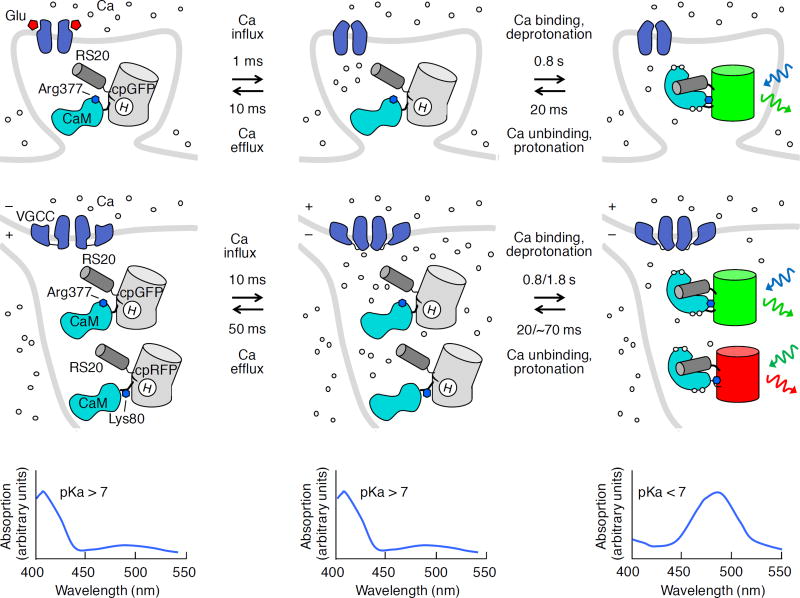Figure 4.
Genetically encoded calcium indicators (GECIs). GECIs respond to calcium with increased fluorescence. Events following a glutamate release event (top row) and a single AP (middle row) that opens voltage-gated calcium channels (VGCC) are shown, with open channels in the first time point and closed channels before the second time point. Calcium-induced binding of calmodulin (CaM) to a peptide from smooth-muscle myosin light-chain kinase (RS20) causes repositioning of Arg377 in GCaMPs and Lys80 in R-GECOs, inducing loss of a proton from the chromophore and an absorbance shift (bottom row). GCaMPs can detect calcium transients induced by synaptic activation (top row) and action potentials (middle row), with increased green emission (rightward green sinusoidal arrow) upon blue excitation (blue sinusoidal arrow). R-GECOs can report APs with red emission (red sinusoidal arrow) upon green excitation (leftward green sinusoidal arrow). Spine calcium kinetics are from ref. 74. Dendrite and soma kinetics are from ref. 75. With repeated neurotransmitter release or prolonged depolarization, calcium rise and decay times will be longer. Times for calcium half-binding or half-unbinding are for GCaMP6f-RS09 and jRGECO1a, separated by a slash (/), as these are respectively the fastest green and red GECIs tested in neurons. GCaMP6f values were used for jRGECO1a, as they show similar in cellulo kinetics, but only GCaMP6f in vitro kinetics were measured. Half-binding times for GCaMP6f and GCaMP6f-RS09 were calculated by normalizing the half-binding time of GCaMP3-RS06 (ref. 91) after a 200-nM step at 25 °C (ref. 114) by the kon values of GCaMP6f and GCaMP6f-RS09 relative to GCaMP3-RS06 at 25 °C (ref. 91). Times at 37 °C may be similar, as GCaMPs show little temperature dependence in binding rates93. Unbinding times shown measured at 37 °C for GCaMP6fRS09 and GCaMP6f93. Note that observed rise times of fluorescence transients in cells will be mostly determined by calcium decay kinetics.

